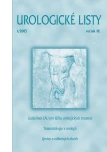-
Medical journals
- Career
TRAUMA OF INERVATION OF LOWER URINARY TRACT
Authors: prof. Tomáš Hanuš, DrSc.
Authors‘ workplace: Urologická klinika 1. LF UK a VFN, Praha
Published in: Urol List 2005; 3(1): 40-46
Overview
Detrusor and urether form one functional whole. Neural urination control is running on the cerebral, spinal and peripheral levels. The most frequent cause of lesion of urinary tract inervation is spinal injury or surgical operations in pelvis. The classification of lower urinary tract dysfunctions is based on the result of urodynamic examination and it divides the function of detrusor and urether into the normal, hyperactive and hypoactive one. The treatment of lower urinary tract dysfunctions developped in the result of lower urinary tract inervation trauma is pharmacologic, protetic, surgical or combined.
KEY WORDS:
spinal cord injury, pelvic surgery, neurogenic bladder, peripheral neuropathy, urodynamic investigation, vesicourethral voiding dysfunction
Sources
1. Abrams P, Blaivas JG, Stanton SL et al. The standardisation of terminology of lower urinary tract function. The International Continence Society Committee on Standardisation of Terminology. Scand J Urol Nephrol Suppl 1988; 114 : 5-19.
2. Annoscia S, Lozzi C, Di Mauro A et al. Urodynamic evaluation of vesico-urethral function after major pelvic surgery. Urodinamica 1994; 4 : 63-73.
3. Appell RA. Injectables for urethral incompetence. World J Urol 1990; 8 : 208.
4. Bartoníček J. Zlomeniny thorakolumbální páteře. Praha: Scientia Medica 1995 : 123.
5. Bors E. Neurogenic bladder. Urol Surv 1957; 7 : 177-250.
6. Brindley GS, Rushton DN. Long-term follow up of patients with sacral anterior root stimulator implants. Paraplegia 1990; 28 : 469-475.
7. Comarr AE. The practical urological management of the patient with spinal cord injury. Br J Urol 1959; 31 : 1-46.
8. Doležel J. Traumatická léze míšní. Urologie pro praxi 2004; 5(4): 146 -155.
9. Flood HD et al. Long-term results and complications using augmentation cystoplasty in reconstructive urology. Neurourol Urodyn 1995; 14 : 197-309.
10. Guttmann L, Frankel H. The value of intermittent catheterisation in the early management of traumatic paraplegic and tetraplegic. Paraplegia 1966; 4 : 63-84.
11. Hanuš T. Poruchy mikce. Brno: IDVPZ 1991 : 63.
12. Kershen RT, Boone TB. Peripheral neuropathies of the lower urinary tract, following pelvic surgery and radiation therapy. In: Corcos E.J, Schick E.: Textbook of the Neurogenic Bladder, s.235-243. Martin Dunitz, Tailor and Francis Group, London 2004.
13. Kontothanassis D, Popert R, Mundy AR. Long term results of the artificial urinary sphincter in 250 patients. Eur Urol 1996; 30(Suppl 2): 421A.
14. Krane RJ, Siroky MB (eds). Clinical neuro-urology. Boston: Little, Brown & Co 1991 : 602.
15. Lapides J, Diokno AC, Silber SJ, Lowe BS. Clean intermittent self-catheterization in treatment of urinary tract disease. J Urol 1972; 107 : 458-461.
16. Light JK, Lapin S, Vohra S. Combined use of bowel and the artificial urinary sphincter in reconstruction of the lower urinary tract: infectious complications. J Urol 1995; 153(2): 331-333.
17. McFarlane JP, Foley SJ, Shah PJR. Long-term outcome of permanent urethral stents in the treatment of detrusor-sphincter dyssynergia. Br J Urol 1996; 78 : 729-732.
18. McGuire EJ, Noll F, Maynard F. A pressure management system for the neurogenic bladder after spinal cord injury. Neurourol Urodyn 1991; 10(3): 223-230.
19. Minini GF, Paganotti C, Roggia A. Radical hysterectomy and nerve-sparing technique. Urodinamica 1994; 4 : 59-62.
20. Nitti VW, Adler H, Combs AJ. The role of urodynamics in the evaluation of voiding dysfunction in men after cerebrovascular accident. J Urol 1996; 155 : 263-266.
21. Ross CJ, Gibbon NOK, Damanski M. Division of the external sphincter in the treatment of neurogenic bladder. Br J Surg 1967; 54 : 627-628.
22. Schuerch B, Stoehrer M, Kramer G, Schmidt DM, Gaul C, Hauri D. Botulinum - A toxin for treating detrusor hyperreflexia in spinal cord injured patients: a new alterantive to anticholinergic drugs? J Urol 2000; 164 : 692-697.
23. Singh G, Thomas DG. Artificial Sphincter in patients with neurogenic bladder dysfunction. Br J Urol 1996; 77 : 252-255.
24. Tanagho EA, Schmidt RA. Electrical stimulation in the clinical management of the neurogenic bladder. J Urol 1988; 140 : 1331-1339.
25. Webb DR, Fitzpatrick JM, O´Flynn JD. A 15-year follow - up of 406 consecutive spinal cord injuries. Br J Urol 1984; 56 : 614-617.
26. Wein AJ. Classification of neurogenic voiding dysfunction. J Urol 1981; 125 : 605-609.
27. Wendsche P. Poranění páteře a míchy. Brno: IDVPZ 1996 : 50.
28. Jarolím L, Babjuk M, Grim M, Naňka O, Hanuš T, Janský M, Povýšil C. Anatomický podklad a klinická interpretace ortotopické neoveziky u ženy. Čes Urol 1998; 2(3): 30-34.
Labels
Paediatric urologist Urology
Article was published inUrological Journal

2005 Issue 1-
All articles in this issue
- PRESENT VIEW OF URETERAL INJURIES
- RENAL TRAUMA AND THE PRESERVATION OF RENAL PARENCHYMA
- BLADDER TRAUMA
- URETHRAL TRAUMA IN MALES - IMMEDIATE AND DELAYED TREATMENT
- INJURIES TO THE EXTERNAL GENITAL ORGANS
- TRAUMA OF INERVATION OF LOWER URINARY TRACT
- BLOOD CARE AT ELECTIVE UROLOGICAL OPERATIONS
- OPTIMAL METHOD OF INTRAABDOMINAL PRESSURE MEASUREMENT
- STRESS URINARY INCONTINENCE IN WOMEN AND ITS PHARMACOLOGIC TREATMENT OPTIONS
- Urological Journal
- Journal archive
- Current issue
- Online only
- About the journal
Most read in this issue- OPTIMAL METHOD OF INTRAABDOMINAL PRESSURE MEASUREMENT
- INJURIES TO THE EXTERNAL GENITAL ORGANS
- URETHRAL TRAUMA IN MALES - IMMEDIATE AND DELAYED TREATMENT
- BLADDER TRAUMA
Login#ADS_BOTTOM_SCRIPTS#Forgotten passwordEnter the email address that you registered with. We will send you instructions on how to set a new password.
- Career

